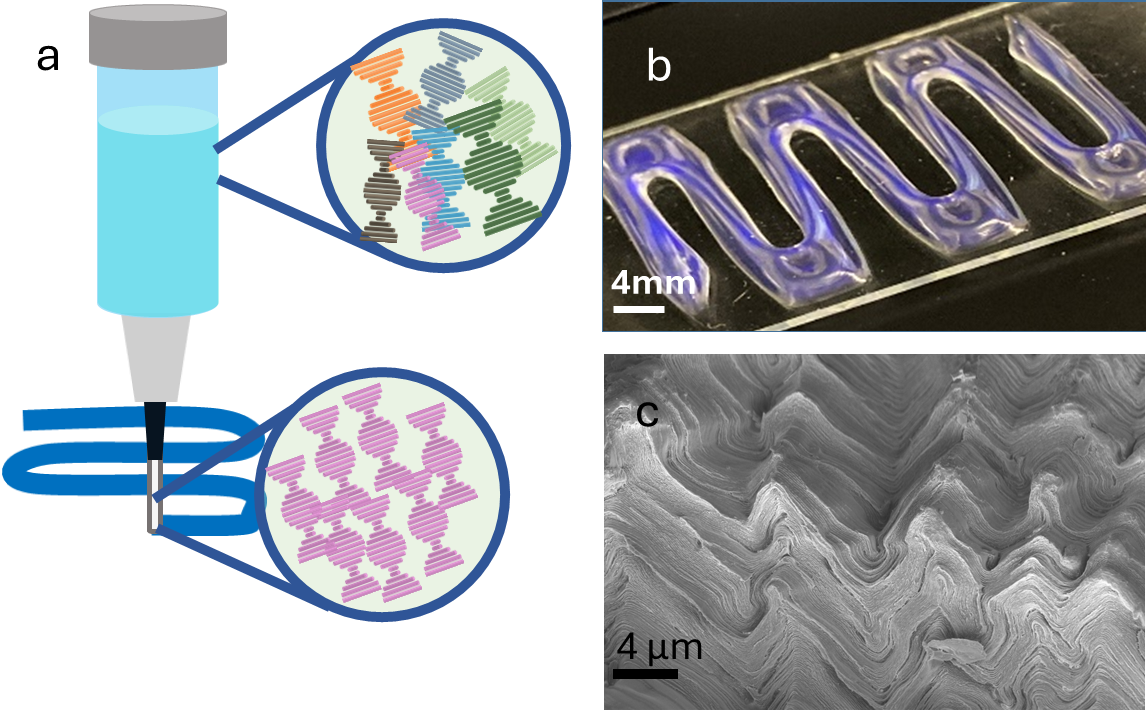School Seminar: Dr Ahu Gumrah-Parry, The University of Manchester
Wednesday, 21 May 2025 11:00am – 12:00pm
This seminar will be delivered in Carslaw Lecture Theatre 173
Speaker: Dr Ahu Gumrah-Parry
Host: Prof. Chiara Neto
Title: Self-Assemblies Bridging the Length Scales for Biomimetic and Functional Materials
Abstract
Self-assembly as a process has the capacity to develop functional materials with well-defined structures. While in natural material constructs the self-assembly on the molecular, mesoscale and microscale work coherently to form function, for the synthetic analogues an overarching challenge is to bridge the processes at different length scales to transfer the local structures to useful macroscopic material properties.
For self-assembly, we work with anisotropic colloidal particles made of cellulose which we isolate using acid digestion. These isolated cellulose nanoparticles (CNCs) in aqueous suspensions simultaneously form cholesteric photonic films that show circular dichroism through evaporation-driven self-assembly. Drop-casting of CNC suspensions is a highly practical and cost-effective method, to form these photonic cellulose films. However, the drying of such liquid droplets of colloidal CNC suspensions is a highly complex process with evaporative flux, internal diffusion and mass transport controlling the distribution of cellulose particles in the final dried film’s anatomy. This talk will cover selected examples using cellulosic building blocks in colloidal and polymeric forms in a self-assembly context. Our group has been investigating many aspects of these films, such as the optical response and co-assembly of these interesting building blocks to modulate their photonic response and model their left-handed self-assembly [1-3]. In my talk, I will give an overview of these studies.
I will also introduce our new line of work on Hydroxypropyl cellulose (HPC) a water-soluble polymeric derivative of cellulose. Concentrated aqueous solutions of HPC form right-handed lyotropic cholesteric phases spontaneously [5-7], Figure 1. One avenue we use HPC is as a model material system to mimic the structural organisation in Scarab beetles. Therefore, in the second part of my talk, I will demonstrate the formation of these mesophases and colour tuning in HPC mesophases and introduce our work on further functionalisation of HPC polymers via green routes towards colourful biocompatible water-resistant alternative polymer systems.

Figure 1. a) Illustration of the 3d printing of the functionalized HPC mesophases with b) uniform structurally coloured filaments and c) the second-degree microstructural hierarchy induced by the shear forces through the 3d processing
References
- Dumanli, A.G., et al., Digital Color in Cellulose Nanocrystal Films. ACS Applied Materials & Interfaces, 2014. 6(15): p. 12302-12306.
- Espinha, A., et al., Shape Memory Cellulose-Based Photonic Reflectors. ACS Applied Materials & Interfaces, 2016. 8(46): p. 31935-31940.
- Balcerowski, T. and A.G. Dumanli, Xanthan-Induced Gelation in Cellulose Nanocrystal Suspensions: Altering Self-Assembly and Optical Purity. Advanced Optical Materials, 2024. n/a(n/a): p. 2401730.
- Werbowyj, R.S. and D.G. Gray, Optical properties of hydroxypropyl cellulose liquid crystals. I. Cholesteric pitch and polymer concentration. Macromolecules, 1984. 17(8): p. 1512-1520.
- Chan, C.L.C., et al., Visual Appearance of Chiral Nematic Cellulose-Based Photonic Films: Angular and Polarization Independent Color Response with a Twist. Advanced Materials, 2019. 31(52): p. 1905151.
- Balcerowski T, et al., Two-degree hierarchical design via 3-d printing of cholesteric phases of cellulose. Small, 2022.
- Ren H., et.al. Achieving a full color palette with thickness, temperature, and humidity in cholesteric hydroxypropyl cellulose, Frontiers in Photonics, Volume 4, 2023
Bio
Dr. Ahu Gümrah Dumanlı-Parry is a Materials Chemist and the first recipient of the bp-ICAM Kathleen Lonsdale Research Fellowship received in 2019 for her work on bio-inspired advanced materials. Dr Dumanli-Parry’s research group (Bio-inspired Functional Materials-BioFuM- https://www.biofumlab.com) focuses on understanding the self-assembly process in nature and mimicking it to produce structurally ordered materials via the self-assembly process. With her research group, Dr Dumanli-Parry investigates the complex relationship between the intrinsic properties of the colloidal building blocks and the physical effects that modulate the self-assembly process to build optically active matter for sensing technologies and shape-morphing systems as well as light-harvesting applications.
Before joining the University of Manchester Dr Dumanli-Parry worked at Imperial College London, University of Cambridge (PDRA and Schlumberger Faculty for Future Research Fellow) and Adolphe Merkle Institute, Fribourg (Group Leader). She received her PhD from Sabanci University in Istanbul under the supervision of Prof Yuda Yurum, working on the controlled production of morphologically differentiated carbon nanotubes.

